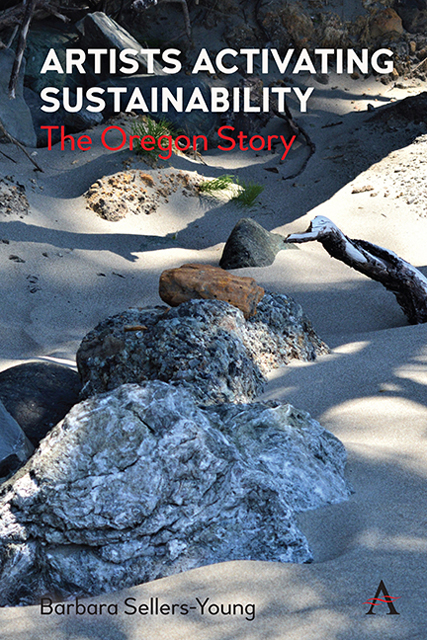Book contents
- Frontmatter
- Dedication
- Contents
- Acknowledgments
- List of Figures
- Introduction: Art, Environment and Metaphor
- 1 Environmental Activism, Arts and the Land of Eden Landscape One: High Desert Basin and Range
- Landscape One High Desert Basin and Range
- Landscape Two Columbia Gorge and Plateau
- Landscape Three Cascade Range
- Landscape Four The Willamette Valley
- Landscape Five Rogue River Valley
- Landscape Six Oregon Coast and Coast Range
- Index
7 - Willamette Valley’s Sanctuary Stage
Published online by Cambridge University Press: 10 January 2023
- Frontmatter
- Dedication
- Contents
- Acknowledgments
- List of Figures
- Introduction: Art, Environment and Metaphor
- 1 Environmental Activism, Arts and the Land of Eden Landscape One: High Desert Basin and Range
- Landscape One High Desert Basin and Range
- Landscape Two Columbia Gorge and Plateau
- Landscape Three Cascade Range
- Landscape Four The Willamette Valley
- Landscape Five Rogue River Valley
- Landscape Six Oregon Coast and Coast Range
- Index
Summary
Sanctuary: a place of safety
The introduction to this volume quotes the 2011 James Irvine Foundation published report titled Getting in on the Act. It is included again as the report's observations are fundamental to the changes that have taken place in the arts throughout the twentieth and into the twenty-first century.
We are in the midst of a seismic shift in cultural production, moving from a “sit-back-and-be-told culture” to a “making-and-doing-culture.” Active or participatory arts practices are emerging from the fringes of the Western cultural tradition to capture the collective imagination. Many forces have conspired to lead us to this point. The sustained economic downturn that began in 2008, rising ticket prices, the pervasiveness of social media, the proliferation of digital content and rising expectations for self-guided, on-demand, customized experiences have all contributed to a cultural environment primed for active arts practice. This shift calls for a new equilibrium in the arts ecology and a new generation of arts leaders ready to accept, integrate and celebrate all forms of cultural practice. This is, perhaps, the defining challenge of our time for artists, arts organizations and their supporters—to embrace a more holistic view of the cultural ecology and identify new possibilities for Americans to engage with the arts.
Essentially, the Irvine report was documenting the consequence of an intense political engagement in which many visual and performing artists around the globe became committed to creating art that represented the identity and expressed the concerns of a community. In terms of theater, this activist performance form is an extension of the engaged theater of German director and playwright Bertolt Brecht (1893–1956) and the performance methods of Brazilian Augusto Boal (1931–2009), whose performances broke the fourth wall of the proscenium and encouraged the stage as a space of community dialogue. As Cohen-Cruz points out, “theater is not a self-contained entity but rather gains meaning in context, integrated into people's lives.”
This chapter traces Daniel Stone and Tinamarie Ivey's evolution of an approach to theater in Oregon's Willamette Valley that builds on the performance theories of Brecht and Boal that they refer to as “sanctuary theater” or in terms of its company name, Sanctuary Stage. Merriam Webster Dictionary notes that sanctuary is a political concept derived from the Latin sanctuarium with a history primarily associated with worship.
- Type
- Chapter
- Information
- Artists Activating SustainabilityThe Oregon Story, pp. 121 - 134Publisher: Anthem PressPrint publication year: 2022



